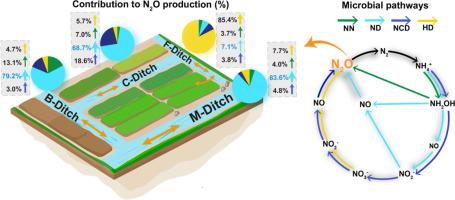Revealing microbial pathways of N2O production in agricultural ditches
IF 12.4
1区 环境科学与生态学
Q1 ENGINEERING, ENVIRONMENTAL
引用次数: 0
Abstract
Agricultural ditches are recognized as hotspots of nitrous oxide (N2O) emissions, yet the contributions of different microbial pathways under varying environments remain largely unknown. In this study, we quantified N2O production from four microbial pathways (nitrifier nitrification, nitrifier denitrification, nitrification-coupled denitrification, and heterotrophic denitrification) across a gradient of ditch types (from large to small: main, branch, collector, and field ditches). Using a dual isotope tracing technique (15N-18O), we distinguished pathway-specific N2O production under different oxygen and organic carbon (C) conditions. Nitrifier denitrification dominated N2O production in the three largest ditch types (contributing 68.7-83.6%), while heterotrophic denitrification accounted for 85.4% of the total N2O production in the field ditch. As organic C increased, heterotrophic denitrification-derived N2O production increased significantly, whereas the contribution of nitrifier denitrification of N2O production decreased significantly. As oxygen concentration decreased, all pathways-derived N2O rates increased, while the contribution of nitrifier denitrification remained unchanged. Key nitrifiers, including Nitrososphaeraceae sp. TA-21, Nitrospira sp. Clade C and comammox Nitrospira kreftii, regulated N2O production across NH4+-derived pathways, with their influence modulated by environmental context. These findings improve our understanding of N2O production in agricultural ditches, providing insights into developing process-based models and mitigation strategies.

揭示农业沟渠生产N2O的微生物途径
农业沟渠被认为是氧化亚氮(N2O)排放的热点,但不同环境下不同微生物途径的贡献在很大程度上仍然未知。在这项研究中,我们量化了四种微生物途径(硝化器硝化、硝化器反硝化、硝化耦合反硝化和异养反硝化)在沟渠类型(从大到小:主沟渠、分支沟渠、收集器沟渠和田间沟渠)上的N2O产量。利用双同位素示踪技术(15N-18O),我们区分了不同氧和有机碳(C)条件下特定途径的N2O产量。3种最大沟型N2O产量以硝化反硝化作用为主(贡献68.7-83.6%),异养反硝化作用占田间沟N2O总产量的85.4%。随着有机碳的增加,异养反硝化N2O产量显著增加,而硝化菌反硝化对N2O产量的贡献显著降低。随着氧浓度的降低,所有途径衍生的N2O速率均增加,而硝化菌反硝化作用的贡献保持不变。主要的硝化菌,包括亚硝基螺旋藻科sp. TA-21、亚硝基螺旋藻sp. Clade C和克氏亚硝基螺旋藻,通过NH4+衍生的途径调节N2O的产生,其影响受环境背景的调节。这些发现提高了我们对农业沟渠中N2O产生的理解,为开发基于过程的模型和缓解策略提供了见解。
本文章由计算机程序翻译,如有差异,请以英文原文为准。
求助全文
约1分钟内获得全文
求助全文
来源期刊

Water Research
环境科学-工程:环境
CiteScore
20.80
自引率
9.40%
发文量
1307
审稿时长
38 days
期刊介绍:
Water Research, along with its open access companion journal Water Research X, serves as a platform for publishing original research papers covering various aspects of the science and technology related to the anthropogenic water cycle, water quality, and its management worldwide. The audience targeted by the journal comprises biologists, chemical engineers, chemists, civil engineers, environmental engineers, limnologists, and microbiologists. The scope of the journal include:
•Treatment processes for water and wastewaters (municipal, agricultural, industrial, and on-site treatment), including resource recovery and residuals management;
•Urban hydrology including sewer systems, stormwater management, and green infrastructure;
•Drinking water treatment and distribution;
•Potable and non-potable water reuse;
•Sanitation, public health, and risk assessment;
•Anaerobic digestion, solid and hazardous waste management, including source characterization and the effects and control of leachates and gaseous emissions;
•Contaminants (chemical, microbial, anthropogenic particles such as nanoparticles or microplastics) and related water quality sensing, monitoring, fate, and assessment;
•Anthropogenic impacts on inland, tidal, coastal and urban waters, focusing on surface and ground waters, and point and non-point sources of pollution;
•Environmental restoration, linked to surface water, groundwater and groundwater remediation;
•Analysis of the interfaces between sediments and water, and between water and atmosphere, focusing specifically on anthropogenic impacts;
•Mathematical modelling, systems analysis, machine learning, and beneficial use of big data related to the anthropogenic water cycle;
•Socio-economic, policy, and regulations studies.
 求助内容:
求助内容: 应助结果提醒方式:
应助结果提醒方式:


